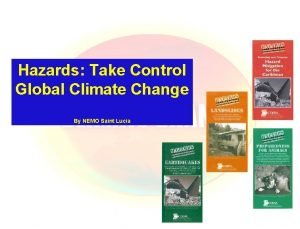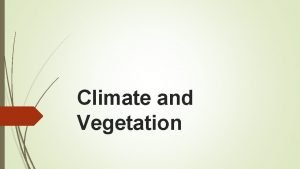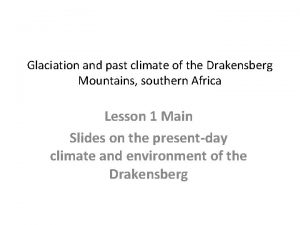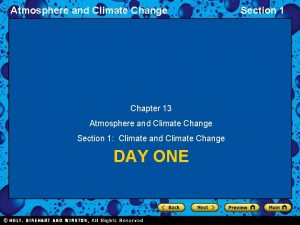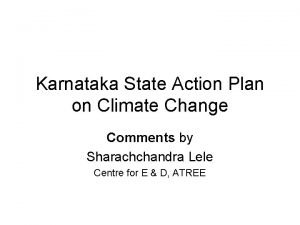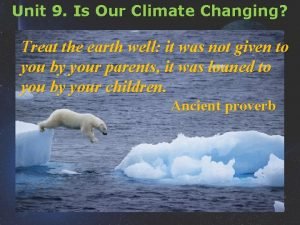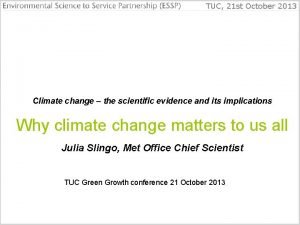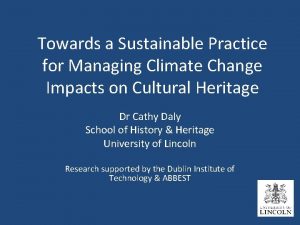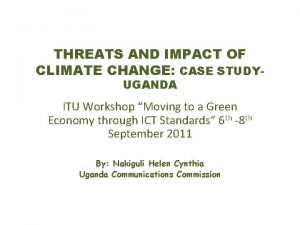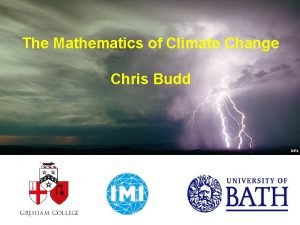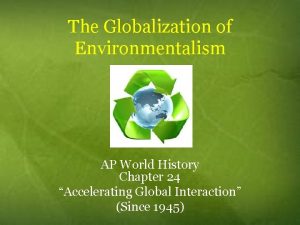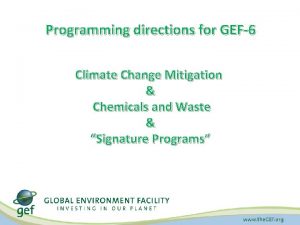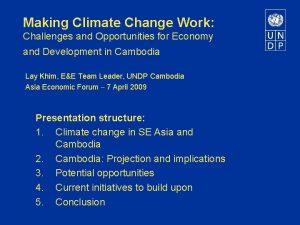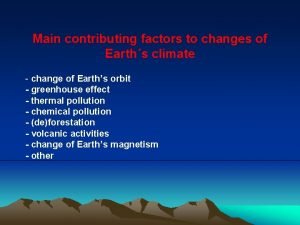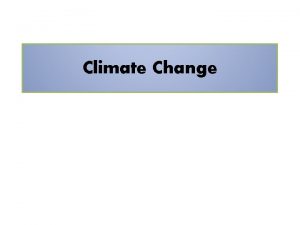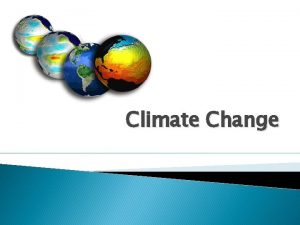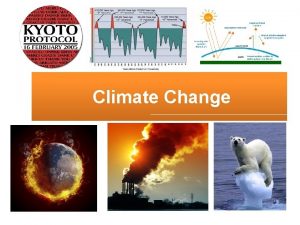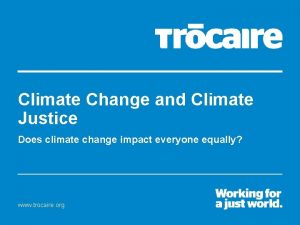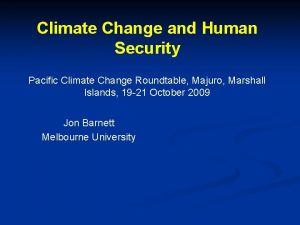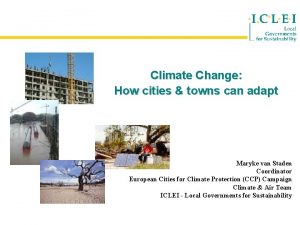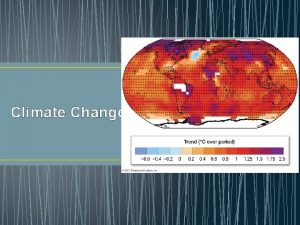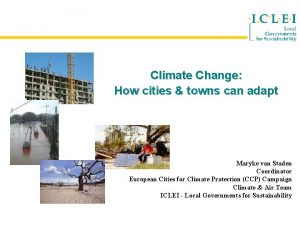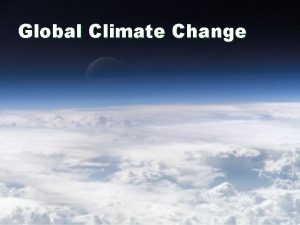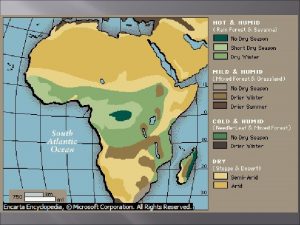CLIMATE CHANGE AND SECURITY IN AFRICA WITH FOCUS

























- Slides: 25

CLIMATE CHANGE AND SECURITY IN AFRICA WITH FOCUS ON THE GREATER HORN OF AFRICA, PARIS, 20 JANUARY 2009 Bwango Apuuli IGAD Climate Prediction and Applications Centre (ICPAC)

OUTLINE • • • Introduction Climate change and natural resources Past, present climate migrations and conflicts Future climate change scenarios for the region Impacts, vulnerability and adaptation to climate change • Adaptation strategies at national and regional levels • Conclusion

10 GHA Countries Sudan Eritrea Djibouti Ethiopia Somalia Uganda Kenya Rwanda Burundi Tanzania

INTRODUCTION • GHA prone to extreme climate events such as droughts and floods with severe negative impacts on key socio-economic sectors. • More than half of the region is classified as Arid or Semi-Arid Lands (ASALs) • Most livelihoods tied to climate sensitive natural resources • Shared natural resources

INTRODUCTION CONTD • Rain-fed agriculture • The droughts are often associated with lack of pasture, food, water, energy, loss of society livelihoods, etc • Climate extremes lead to 1. loss of life and property 2. forced large-scale population displacement 3. poverty 4. Other miseries

INTRODUCTION CONT… Consequences 1. the region has experienced conflicts ranging from interstate tensions 2. interstate conflicts 3. cross border community conflicts over limited water, grazing land 4. Food insecurity

Forced migration due to conflict

Scarcity in pasture leading to conflict

Climate change, natural resources and security Climate Change significantly affects security in three distinct ways ü Warming and drying in some regions – will reduce agricultural potential and undermine ‘ecosystem services’ ü Increase in extreme weather events – floods and drought resulting into migration ü Sea level rise – submerge low lying coastal areas resulting to permanent relocation

Failed harvest caused by floods


Floods often follow or precede droughts

Migration with livestock due to drought

DROUGHT IMPACTS Reduced Crop production Starvation due to lack of Rainfall Loss of Livestock

Past and present changes in natural resources and livelihood patterns • Effects of future climate change on agriculture may be evaluated by using analogues of climate conditions that occur in the present time, such as current periods of drought and floods. • Maps below show effects of the 2001 drought on the vegetation conditions in Africa. Vegetation condition measured by vegetation health (VH - index). • Source: NOAA/NESDIS; http: //www. nesdis. noaa. gov/.

Analogues: Drought, Floods Africa vegetation health (VH - index) Vegetation health: Red – stressed, Green – fair, Blue – favorable Source: NOAA/NESDIS

Trends in rainfall patterns

Declining maize production per capita Source: FEWSnet Pop~33 M (2005) and Growth Rate ~ 2. 56%

Multiple Interactions • Climate change is one stress among many affecting agriculture and the population that depends on it – Integration of results is essential to formulate assessments relevant to policy • Potential future consequences depend on: – The region and the agricultural system Where? – The magnitude [How much? Scenarios are important. ] – The socioeconomic response [What happens

CLIMATE EXTREMES: WILL THE PATTERNS CHANGE Causes El Niño / LA Niña Hot & cold spells Droughts River basin flooding Tropical cyclones Heavy precipitations (rain or snow) Storm surges Ice Storms Dust storms Storm (winds) Wildland fires & haze Hail&Lightning Mud & landslides Flash floods Avalanches Tornadoes

Adaptation Strategies • • National Level include Water harvesting Irrigation Drought/pest resistant crops Reforestation Energy efficiency e. g. stoves Use of renewable energy e. g. solar, wind

Adaptation Strategies Cont… • Regional Level include harmonization of policies e. g. power pooling, EAC water release policy on L. Victoria & its basin • Regulation e. g. fishing between Kenya & Uganda on L. Victoria (Migingo Island) • Optimum use & protection of transboundary waters e. g. River Nile

Consequences for EU-Africa Relations • Devlpmt resources will continue to be diverted to CRM • EU will be expected to support progms for CRM • EU will be expected to continue to support CC adaptation in Africa: appropriate technologies, GMES, NAPAs

Conclusion • Climate change will get worse with more frequent and severe extreme events such as droughts, floods • Exacerbate conflicts, famine, food insecurity • Govts need to adopt appropriate policies to support adaptation • Mainstream climate change adaptation into national planning

 Climate change 2014 mitigation of climate change
Climate change 2014 mitigation of climate change Climate change national security threat
Climate change national security threat Porters strategies
Porters strategies Business level strategy cost leadership
Business level strategy cost leadership Privatesecurity
Privatesecurity Focus on form vs focus on forms
Focus on form vs focus on forms Actor focus vs object focus
Actor focus vs object focus Equatorial climate vegetation
Equatorial climate vegetation Climate zones in africa
Climate zones in africa 29⁰
29⁰ Climate change meaning
Climate change meaning Chapter 13 atmosphere and climate change section 1
Chapter 13 atmosphere and climate change section 1 Chapter 13 atmosphere and climate change
Chapter 13 atmosphere and climate change Persuasive essay about global warming
Persuasive essay about global warming Karnataka state action plan on climate change
Karnataka state action plan on climate change What causes wind to blow brainpop
What causes wind to blow brainpop Unit 9 climate change
Unit 9 climate change Conclusion of climate change
Conclusion of climate change Youreuropemap.com
Youreuropemap.com Conclusion of climate change
Conclusion of climate change Mathematics of climate change
Mathematics of climate change Globalization definition ap world history
Globalization definition ap world history Climate change mitigation
Climate change mitigation Pc 414
Pc 414 Conclusion of climate change
Conclusion of climate change Factors of climate change
Factors of climate change

